Comparison of substitute support cushion materials used for patient treatment in radiation therapy
Keywords:
radiotherapy technique, dose attenuation, support cushionAbstract
Background: Radiation therapy is one of the most common treatment options for cancer. An accuracy and precision of patient positioning is required for radiotherapy. Support cushion is used to provide stabilization and comfort during treatment in every fractionated radiotherapy.
Objective: To compare the dose attenuation and patient comfort of each support material among commercial (Macromedics mattress) and other replacement materials.
Material and methods: The TPE Yoga Mat, Latex mattress, EVA foam and rug were selected to study. There were two procedures to study the suitability of these materials. The first process was the radiation dose attenuation test measured by 0.6 cc Farmer-type ionization chamber. The 20-cm thick of solid water phantom was used and the source to surface distance of 87 cm was set. Then, radiation dose comparison of 3D, IMRT and VMAT plans was performed among different types of material support and the dose attenuation of each material was calculated. The second part was the survey of patient comfort from 26 volunteers after 5-minute resting on the support materials.
Results: The results from radiation dose attenuation test showed that the TPE yoga mat (0.19%-1.08%) and the rug (0.23%-0.70%) had the same radiation dose attenuation with the Macromedics mattress (0.06%-0.57%), while the latex mattress showed the highest dose attenuation (0.77%-2.19%). The results from comfortable test showed that latex mattress was the most comfortable material with the comfortable factor of 0.08±0.27, followed by the rug (1.23±0.91), while there was no significant difference in comfortable level between TPE yoga mat (0.65±0.75) and Macromedics mattress (1.23±0.99).
Conclusion: The most suitable materials to replace Macromedics mattress are the rug, TPE yoga mat and EVA foam, respectively.
References
นพ.วินัย พอล. (2562). รู้จัก "โรคมะเร็ง" ภัยร้ายที่เป็นสาเหตุการเสียชีวิตอันดับต้นๆ. สืบค้นเมื่อ 17 กันยายน 2562, จาก https://www.phyathai.com/article_detail/2886/th/รู้จัก_“โรคมะเร็ง”_ภัยร้ายที่เป็นสาเหตุการเสียชีวิตอันดับต้นๆ.
คณะกรรมการจัดทำแผนการป้องกันและควบคุมโรคมะเร็งแห่งชาติ กรมการแพทย์ กระทรวงสาธารณสุข. แผนการป้องกันและควบคุมโรคมะเร็งแห่งชาติ (พ.ศ. 2561-2565). กรุงเทพมหานคร: กระทรวงสาธารณสุข; 2560.
ไม่ปรากฏผู้เขียน. (2561). International Agency for Research on Cancer. Latest global cancer data: Cancer burden rises to 18.1 million new cases and 9.6 million cancer deaths in 2018.
สาขารังสีรักษาและมะเร็งวิทยา ฝ่ายรังสีวิทยา โรงพยาบาลจุฬาลงกรณ์. (2559). หลักการรักษาด้วยรังสี. สืบค้นเมื่อ 17 กันยายน 2562, จาก https://www.chulacancer.net/patient-list-page.php?id=420&fbclid=IwAR35OBfqN4FcW0-38EbIhFyQ9VvFYdA_1FUO2h1Ub9tj9vgDbsKDv8TZxcs.
Takakura T, Ito Y, Higashikawa A, Nishiyama T, Sakamoto T. Verification of the dose attenuation of a newly developed vacuum cushion for intensity-modulated radiation therapy of prostate cancer. Radiol Phys Technol. 2016;9:270-6.
Pang EPP, Kellie K, Marilyn B, Joshua L, Adelene B, Jeffrey T. A comparison of interfraction setup error, patient comfort, and therapist acceptance for 2 different prostate rafiation therapy immobilization devices. Adv Radiat Oncol. 2017;2:125-131.
Meta A, Kimyon S, Saygili O, Gungor K, Temizer M. Comparison of topical and retrobullar anesthesia in terms of pain experience during silicone oil extraction. Arq Bras Oftalmol. 2018;81:95-101.
Downloads
Published
How to Cite
Issue
Section
License
บทความที่ได้รับการตีพิมพ์เป็นลิขสิทธิ์ของวารสารมะเร็งวิวัฒน์ ข้อความที่ปรากฏในบทความแต่ละเรื่องในวารสารวิชาการเล่มนี้เป็นความคิดเห็นส่วนตัวของผู้เขียนแต่ละท่านไม่เกี่ยวข้องกับ และบุคคลากรท่านอื่น ๆ ใน สมาคมฯ แต่อย่างใด ความรับผิดชอบองค์ประกอบทั้งหมดของบทความแต่ละเรื่องเป็นของผู้เขียนแต่ละท่าน หากมีความผิดพลาดใดๆ ผู้เขียนแต่ละท่านจะรับผิดชอบบทความของตนเองแต่ผู้เดียว




